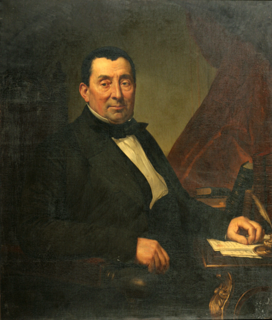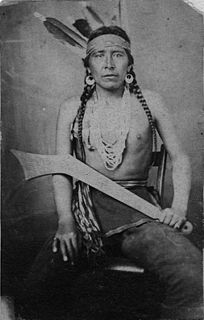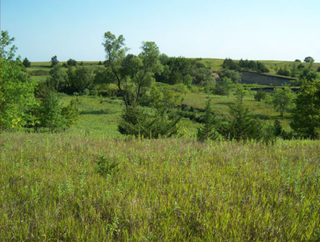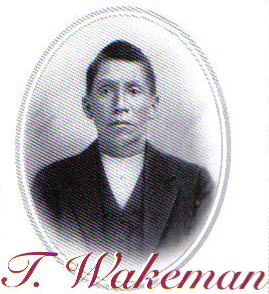
The Lakota are a Native American tribe. Also known as the Teton Sioux, they are one of the three main subcultures of the Sioux people. Their current lands are in North and South Dakota. They speak Lakȟótiyapi—the Lakota language, the westernmost of three closely related languages that belong to the Siouan language family.

The Sioux or Oceti Sakowin are groups of Native American tribes and First Nations peoples in North America. The modern Sioux consist of two major divisions based on language divisions: the Dakota and Lakota and collectively they are known as the Očhéthi Šakówiŋ. The term "Sioux" is an exonym created from a French transcription of the Anishinaabe term "Nadouessioux", and can refer to any ethnic group within the Great Sioux Nation or to any of the nation's many language dialects.

Effigy Mounds National Monument preserves more than 200 prehistoric mounds built by Native Americans. Numerous effigy mounds are shaped like animals, including bears and birds. These were built mostly in the first millennium, by peoples of the Woodland Culture. In 2017, they were featured in the America the Beautiful Quarters Program.

Ramsay Crooks was an American fur trader that immigrated to Canada from Greenock in Scotland. He was the father of American Civil War Colonel William Crooks who served in the 6th Minnesota Regiment. In 1803 Ramsay worked in a trading post on the Great Lakes. He helped W. Price Hunt to organize and lead an overland trip to Astoria in the Oregon Country for John Jacob Astor in 1809 through 1813, as a partner in the Pacific Fur Company. He became general manager of the American Fur Company in 1817 and was president of the company from 1834–1839. While traveling for the fur trade company he dealt with many Native American tribes. He married Abanokue, the daughter of an Ojibwa Chieftain. They had a daughter together, Hester Crooks. Abanokue died around 1825. Crooks then married Emilie Pratte and had nine children. He spent his final days in New York.

Big Eagle was the leader of a band of Mdewakanton Dakota Sioux in Minnesota. In 1862 he and his band joined Taoyateduta and took part in a Sioux uprising. He eventually surrendered.

Camp Dennison was a military recruiting, training, and medical post for the United States Army during the American Civil War. It was located near Cincinnati, Ohio, not far from the Ohio River. The camp was named for Cincinnati native William Dennison, Ohio's governor at the start of the war.

The state of Iowa played a significant role during the American Civil War in providing food, supplies, troops and officers for the Union army.
The 30th Regiment Wisconsin Volunteer Infantry was an infantry regiment that served in the Union Army during the American Civil War.

The Battle of Wood Lake was a battle in the Dakota War of 1862 in September. By that time in the Dakota War of 1862, the Sioux offensive had slowed considerably, and the Minnesota forces were beginning to implement a plan formulated by Governor Alexander Ramsey. Ramsey's plan, implemented by Colonel Henry Hastings Sibley and frontier commander Charles Eugene Flandrau, had the goals to free European-American settlers held captive by the Indians and to "exterminate" or drive the Dakota "forever beyond the borders of the state".

The Dakota War of 1862, also known as the Sioux Uprising, the Dakota Uprising, the Sioux Outbreak of 1862, the Dakota Conflict, the U.S.–Dakota War of 1862 or Little Crow's War, was an armed conflict between the United States and several bands of Dakota. It began on August 17, 1862, along the Minnesota River in southwest Minnesota, four years after its admission as a state. Throughout the late 1850s in the lead-up to the war, treaty violations by the United States and late annuity payments by Indian agents caused increasing hunger and hardship among the Dakota. During the war, the Dakota made extensive attacks on hundreds of settlers and immigrants, which resulted in settler deaths, and caused many to flee the area. This ended with soldiers capturing hundreds of Dakota men and interning their families. A military tribunal quickly tried the men, sentencing 303 to death for their crimes. President Lincoln would later commute the sentence of 264 of them. The mass hanging of 38 Dakota men was conducted on December 26, 1862, in Mankato, Minnesota; it was the largest mass execution in United States history.

The Dakota are a Native American tribe and First Nations band government in North America. They compose two of the three main subcultures of the Sioux people, and are typically divided into the Eastern Dakota and the Western Dakota.
Davenport, Iowa, was part of the Louisiana Purchase. In 1814, during the War of 1812 the British military, along with the Saux and Fox Indian tribes fought against the Americans near Davenport. In August, Major Zachary Taylor, later President, fought a battle east of what is now Credit Island Park, in Davenport. An outpost was set up at Fort Armstrong and George Davenport and Antonie LeClaire were stationed there.

The Village of East Davenport, also known simply as The Village, is located along the Mississippi River on the southeast side of Davenport, Iowa, United States. It was listed as a historic district on the National Register of Historic Places in 1980 as the Davenport Village. At the time of its nomination it included 145 contributing properties, most of which were working-class housing.

Thomas Wakeman was a Native American who organized the first Sioux Indian YMCA. Over the years, 66 Sioux associations have been founded with over 1000 members. As of 2000, Sioux YMCAs, under the leadership of a Lakota Board of Directors, operate programs serving families and youth on the 4,500-square-mile (12,000 km2) Cheyenne River Indian Reservation.
The 1st Dakota Cavalry was a Union battalion of two companies raised in the Dakota Territory during the American Civil War. They were deployed along the frontier, primarily to protect the settlers during the Sioux Uprising of 1862.

The McClellan Heights Historic District is a 188.2-acre (76.2 ha) historic district in Davenport, Iowa, United States. It was listed on the National Register of Historic Places in 1984, at which time it included 354 buildings deemed to contribute to the historic character of the area.

Henry Washington Lee was a 19th-century bishop in the Protestant Episcopal Church in the United States of America. He served as the first Bishop of Iowa from 1854–1874. He also served as Provisional Bishop of Nebraska from 1857–1859 and Provisional Bishop of Kansas, 1860–1864.

Lindsay Park is a 31-acre (0.13 km2) park. located in the Village of East Davenport in Davenport, Iowa, United States. The lower park is a contributing property of the Davenport Village Historic District that has been listed on the National Register of Historic Places since 1980, and the upper park is part of the McClellan Heights Historic District which was listed on the national register in 1984. The whole park was individually listed on the Davenport Register of Historic Properties in 1998. Lindsay Park is owned by the city of Davenport and features a playground, baseball diamonds and views of the Mississippi River, which is immediately to the south of the park. There is a group of architectural sculptures along the Riverfront Parkway, of which Lindsay Park is a part. The park also hosts the annual Riverssance Festival of Fine Art.
The Department of the Northwest was an Army Department created September 6, 1862 by the Union Army to put down the Sioux uprising in Minnesota. It was composed of the forces within the territory of the states of Wisconsin, Minnesota and Iowa, and the Nebraska and Dakota Territories . Nebraska Territory was detached to the Department of the Missouri on Oct. 11 1862.
Joseph Godfrey was an African American who escaped from slavery into a Dakota community in Minnesota, United States, and fought on their side during the Dakota War of 1862. He was the only African-American combatant of the war.

















